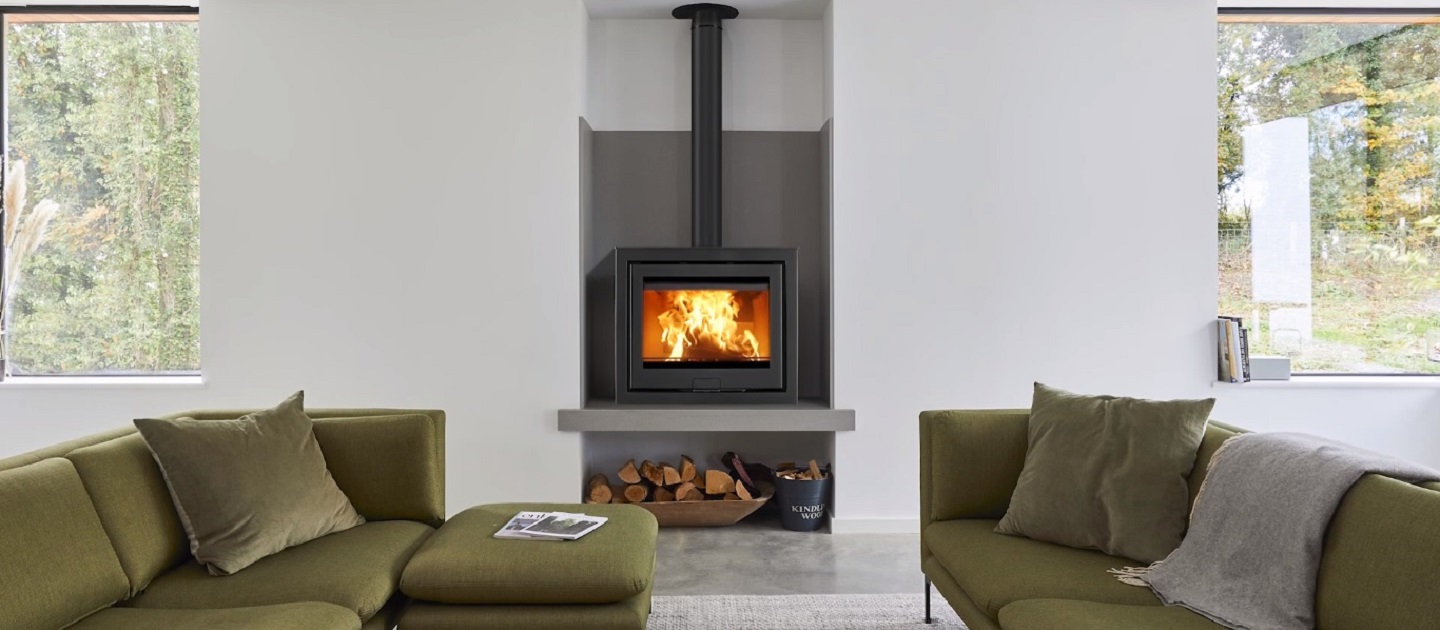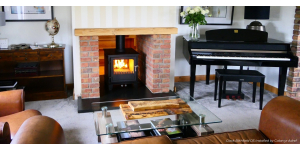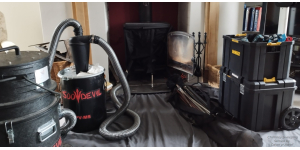There are many factors to consider when purchasing a wood, multifuel, gas, oil or even bioethanol burning stove. Here we look at the main considerations which need to be made, as well as the benefits and drawbacks of each option.
Choosing the right fuel type
What are the different fuel types?
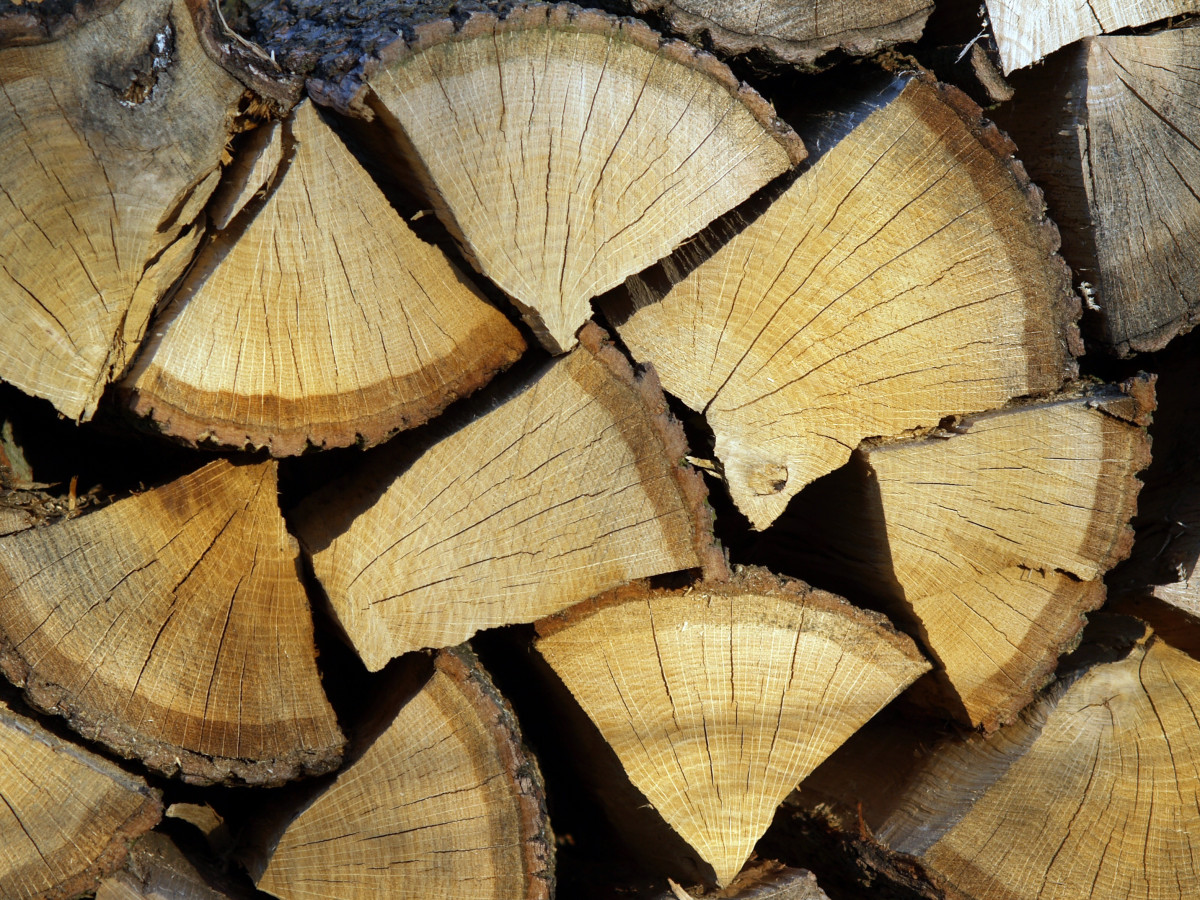
To get started, understanding the fuel types available and what fuel can be used in each type of stove is critical, and there is often confusion about the terms and fuel types available.
The most common fuel types for stoves are wood, solid fuel, gas, electricity, oil, and bioethanol. While most of these fuels are known to us all; there is of course some ambiguity in terms like 'solid-fuel'.
“What is solid fuel?”
Technically the term 'solid fuel' can be taken quite literally; it is a term given to the range of physically solid fuels you can burn, such as wood, coal (although, real coal is now mostly unavailable to purchase), manufactured briquettes and pressure-formed 'logs', and so on.
More often however, 'solid fuel' is used to describe coal and its manufactured alternatives such as briquettes (including smokeless briquettes!). Wood is often therefore spoken of separately, but if we're being fussy, it's all under the umbrella of solid-fuel.
So how do I choose the right fuel type?
The most important factors in choosing the right fuel type are location, availability, storage and convenience.
Equally, if you're in a smoke control zone or there are any other environmental restrictions enforced in the area of the property, this will almost certainly dictate which fuel types you can and cannot use. If unsure, you can speak to your local council authority requesting information regarding any relevant restrictions in your area.
In smoke control zones you will need to look for DEFRA Exempt stoves approved for clean-burning of wood and smokeless fuels in smoke control zones.
Availability: this also ties in quite relevantly to the location too; some fuels are easier to get in some places than others. For example, we install a lot of high efficiency wood burners in Pembrokeshire, here in South-West Wales, as we are blessed with plentiful woodlands which with correct woodland management, is able to produce an ample and sustainable volume of fire wood. This means supply of firewood in Pembrokeshire is very reliable, but in some locations you may find firewood harder to come by than solid fuels perhaps, or of course in some locations such as cities, you may struggle to find any reliable solid fuel suppliers locally due to lower demand.
Storage: having the ability to suitably store your fuel is absolutely vital. In general, wood requires the most storage space, followed by coal and its other derived solid-fuels. If you don't have the room to store these fuels, it would be recommended to avoid these fuel types. Gas and oil similarly are only really suitable options if you have a mains gas supply or can safely and securely house gas bottles externally; or of course in the case of an oil fed stove, you'd need an existing outside oil storage tank; of course you could have one fitted but this would be a fairly extravagant approach to have an oil fed stove.
For homes with no reasonable storage option for fuels; electricity is the usual go-to providing the property has electricity supply. Slowly, the introduction of bioethanol stoves are beginning to be adopted too; offering real live flames without the need for a chimney at all, it's a great option for those who want a real fire rather than the artificial effect of an electric fire, but do not have storage space or fuel supply.
Convenience: convenience needs to be a strongly considered factor in the decision making process of buying a stove. If the intended user has limited mobility for example; expecting them to drag wood or coal inside from the garage each day and bend down to refuel the fire every hour or so wouldn't be the best idea; and perhaps the benefit of self-ignition and remote controllability with a gas or electric stove may be a more sensible option.
These are all factors we would consider with you as part of our pre-installation surveying process.
Choosing the right stove type
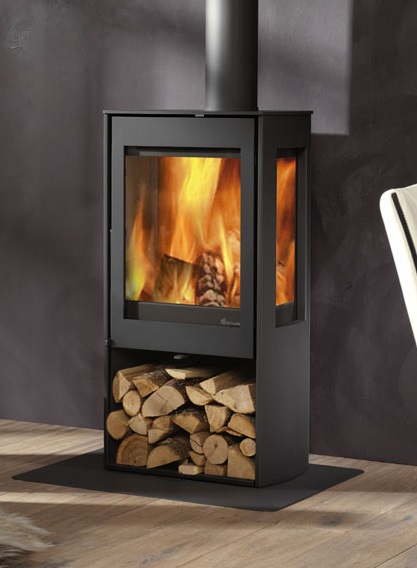
“What is a multi-fuel stove?”
While a wood-burner is designed specifically around efficient combustion of wood, a multifuel stove is designed to allow you to burn other solid fuels as well as wood; so you can burn wood and solid fuel briquettes interchangeably as and when needed. This can offer great diversity and convenience to the user, as you're not limited to one fuel type. Multifuel stoves are a great option when you plan on using a range of solid fuels.
“I only plan on burning wood – should I still get a multi-fuel stove?”
It can be tempting to consider opting for an 'all-rounder' multifuel stove regardless of intention to only burn wood, because why not; right? Well, in general, if you know you will only be burning wood and have no supply issues for fire wood in your area, it may be smarter to purchase a wood-burning stove. The reason for this is they are designed differently in respect to the fire-bed and airflow systems; wood burns more efficiently on a bed of ash with air flow around the base of the fire, while coal and its modern alternatives such as smokeless briquettes etc, burn most effectively when slightly suspended, with air flow provided from underneath the fire bed; this is why you'll find multifuel stoves have the traditional grate & griddle setup for the fire-bed, whilst typically most modern efficient wood burners no longer have a grate at all, and instead the fire is laid directly onto the base of the fire chamber (typically on a protective base-brick made of vermiculite or similar).
However – if you do not have a reliable steady supply of wood, or you have limited capacity for storage and there is a real potential to be caught short on wood occasionally, this is where it becomes sensible to begin considering a multifuel stove, as this would mean if you ever get caught out short on firewood, you'd have the option of picking up any approved solid fuel from a local garage or service station, to keep you going, rather than being limited to burning just wood.
“I don't want to have to keep refuelling the fire – what are my options?”
Keeping on top of refuelling and routinely cleaning out the ashes isn't everyone's cup of tea – and that's ok! Equally, not everybody has the privilege of having appropriate mobility for this is be an achievable task. This is why gas, oil, and electric stoves are also an option; convenient, no mess, no fuss, and many of them have remote control options for even more convenience to the end user. It's also well worth noting there are some fantastically realistic electric fires on the market now; so don't think you're stuck with the classic noisy artificial looking electric stove; there's a real market for high-functioning, eye-pleasing electric stoves now; with technological advances allowing for some truly realistic projections of flame patterns.
In terms of functionality there are a few options to consider with regard to the designs too; such as stoves with built-in log-storage; or stoves with baking ovens to allow you to cook food or bake some delicious cakes and cookies! For this side of things, we've set up a dedicated page to make it easy for you to view all our stoves by their design features.
Helping you choose the right stove type is all part of what we do as part of our pre-installation surveying process with you as a valued customer.
Choosing a suitable size of stove
Usually there will be a certain amount of deciding factors in terms of what size of stove you are able to consider; for example if you have an existing fire chamber the stove is to sit in, then only suitably sized stoves will work, but equally even for a completely new setup without the constraints of an existing fire chamber to work with, suitability will be governed to a large degree by the room size, shape, and orientation; of course there also has to be consideration made for the fact that generally the larger the stove, the greater the heat output (although this isn't strictly always the case).
Another critically important consideration in terms of size suitability, would be the distance to combustibles (and/or non-combustibles, depending on the materials around the area you wish to position the stove). For example, you might like a stove which will fit into the space you have available, but the safe-distances required from the stove to nearest walls / furniture / fixtures may be such that it becomes unsuitable; so in addition to the size of the stove itself, these clearance distances must be observed and accounted for. Some stoves have much lower DTC's (distance to combustibles) than others, even with superior heat outputs in some cases, and this is where speaking to an approved dealer for the stoves you like will likely help you to find a suitable stove for your setup.
Again we can help you with appropriate sizing of a stove as part of our surveying process if you choose to employ our installation services along with the stove purchase.
Choosing the right KW heat output
One of the most frequent and frustrating issues when it comes to stove sizes is when the specified stove is simply too large for the setting. This is an all too frequent problem whereby the output of the stove is simply too high for the space its fitted in - which not only causes inconvenience and a sense of apathy for the end user, but also introduces some very real danger. What tends to happen when a stove is over-specified in terms of heat output, is the stove gets under-fired and starved of airflow by the user closing down the air controls as much as possible, in an effort to limit the heat output. The problem with this is it tends to result in incomplete combustion causing built up in the chimney system, which introduces the risk of chimney fires, and failed discharge of the combustion gases such as Carbon Monoxide, resulting in these poisonous gases creeping back down the chimney system and seeping out into the room and creating a very real and very dangerous risk of Carbon Monoxide poisoning.
Equally frustrating is an under-sized stove, whereby all factors of the property were not properly considered and as such, the heat output to the room leaves much to be desired; not only is this frustrating for the end user but ultimately results in misuse of the stove; over-firing and over-loading of fuel, resulting in excessive wear and damage to important rope seals, fire bricks, and ultimately the stove body itself. Over-firing can cause cracks and splits which aren't always clearly visible without a thorough stove safety inspection, and can be a easy route for smoke and poisonous gases such as Carbon Monoxide to escape from the stove into the room, instead of up the chimney. These cracks, depending on their location, will also affect your ability to control the air flow to the fire bed, resulting in further compounding damage to the stove.
From this, you can easily see that there's a lot more importance to choosing the right size of stove than just preference or style. It is genuinely very important that the stove is suitably sized for the intended space it is to be fitted and used in.
How to calculate appropriate stove KW heat output
Measure the room – you will need to measure the length and width of the room, as well as the height of the room from the floor to the ceiling. For example, the room may be 8 metres long, 5 metres wide, with 2.5 metre high ceilings.
Calculate the room volume – now you have your room measurements, you can multiply them together to get the cubic volume of the room. So if your room measured 8m x 5m and has 2.5m high ceilings, you would multiply 8 by 5, then multiply again by 2.5. (8 x 5 x 2.5 = 100m3)
Factor in insulation levels & other impacting features – this part of the calculation requires an understanding of the property and consideration of features within the space to be heated such as large windows, skylights, any stair cases in the room, draughty doors etc.
For a well insulated modern newbuild property with no notable features that would likely cause additional heat loss, the rule of thumb is to divide the cubic volume of the room by 14. So in our example where we have a 100m3 space, we would need to divide 100 by 14 (100 ÷ 14 = 7.14) – which as you can see, in this example puts us roughly in the ball-park of a 7 – 7.5kw stove.
For a non-newbuild but still basically insulated property, you'd typically divide the volume figure by 12, (100 ÷ 12 = 8.33), putting us closer to an 8.5kw stove.
For an older draughty property with limited insulation, the figure you need to divide by drops down to 10, (100 ÷ 10 = 10), which would put us with this example as requiring roughly a 10kw stove.
As mentioned, there are other factors to consider, if you have skylights or large windows and doors which cause notable cold spots and draughts, you may want to go slightly higher with the heat output than the figures achieved above; but be careful not to over-reach with this; jumping from a 10 to 11kw stove is a notable 10% increase, so don't be too drastic with your adjustments for these additional impacting features.
These calculations can be a little daunting, but don't worry, we can help with this and would always make calculations as part of our install surveying process.
Choosing a design of stove
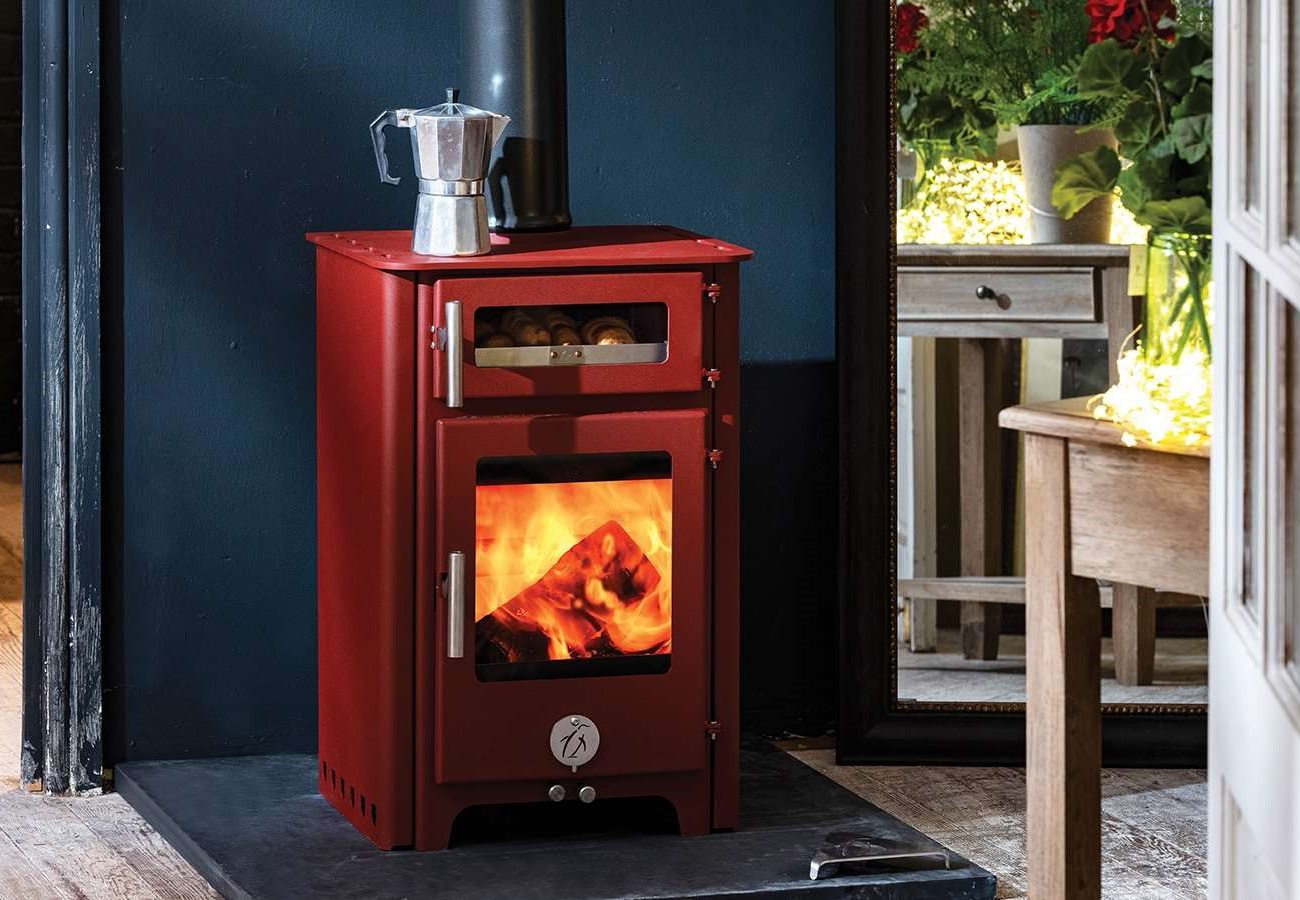
In most cases, the design of the stove is going to be dictated by your preferences. Everyone has their own tastes and choice of style for their home; if you have a traditional property with period features, chances are you're likely going to want to have something quite classic in its appearance, a free-standing traditional stove to tie in with the originality of the property. But equally, like with our installation of the Dik Geurts Oval suspended stove into a very rare heritage inglenook, a modern masterpiece can really look the part in the right setting, combining new with old, in perfect harmony.
In modern homes, upright cylindrical style stoves tend to be a popular choice, often due to space limitations or simply due to their sleek design appealing to the modern minimalist; they can sit beautifully in a corner setting, often on a modern geometric design hearth or 'teardrop' style hearth; both can look truly beautiful in the right setting.
As mentioned previously in this guide there are also functionality options to consider with the designs too; such as stoves with log-stores built underneath; or stoves with top-ovens to allow you to cook food or bake some delicious cakes and cookies! There are a few options to consider in this regard; so to make this a little easier we've set up a page specifically to allow you to view all our stoves by design feature.
So, after so many considerations on size, output, fuel, features and so on, the design is – at least for the most part – the area you get to choose based quite simply on what you like, and what you want in your home. Thank goodness for that!
Whilst the style/design of stove is mostly customer-preference, we are also happy to assist with this if you're unsure what options are available. Either way we would strongly recommend you familiarise yourself with the options by viewing our stoves by feature page first, both for inspiration and understanding of the features available.

